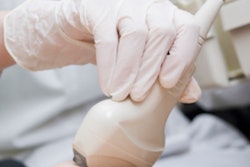
Supplemental ultrasound screening for women with dense breasts finds cancers that mammography does not, but it also leads to many follow-up studies at short intervals. BI-RADS 3 lesions could be followed up at 12 months, however, according to preliminary results presented recently at RSNA 2016 in Chicago.
In a study that included 335 patients with BI-RADS 3 lesions, follow-up of those patients at a yearly interval instead of at six months did not miss any cancers, according to a team led by Dr. Richard Barr, PhD, of Northeast Ohio Medical University in Rootstown, OH. A yearly follow-up strategy would also sharply lower the patient recall and biopsy rates while increasing the positive biopsy rate.
"Changing the BI-RADS category 3 ultrasound recommendation to yearly follow-up should be considered," he said.
Not cost-effective
Supplemental breast ultrasound screening for women with dense breasts can detect node-negative cancers not found on screening mammography. However, the combination of a large number of short-term interval follow-ups and a low positive biopsy rate is not cost-effective, Barr said.
"This has been the indication why insurance companies are reluctant to pay for this examination," he said. "The majority of short-term interval follow-ups and negative biopsies are due to BI-RADS 3 lesions ... with an incidence of cancer of less than 1%."
The researchers decided to perform a prospective study to evaluate the effect of following BI-RADS 3 lesions detected on supplemental ultrasound at one year instead of recommending a six-month follow-up or biopsy. Barr and colleagues asked patients receiving a negative screening mammogram (BI-RADS 1 or 2) with density 3 or 4 breasts and any breast cancer risk to participate in the study. They received a free automated volume whole-breast screening ultrasound in exchange for participating in the study.
All studies were performed on an S2000 automated breast volume scanner (ABVS) (Siemens Healthineers) with a 15-cm L14-5 transducer by sonographers with training in ABVS. Three to five views of each breast were performed to scan the entire breast; the settings were based on the patient's breast cup size, Barr said.
A radiologist with two years of experience with ABVS and 20 years of experience in breast ultrasound then read the studies. All ABVS exams were read as BI-RADS 1, 2, 3, or 0. The category 0 patients were scheduled for a handheld breast ultrasound scan of the abnormality, including Doppler and elastography.
No biopsies, cancer cases
The researchers plan to follow all BI-RADS 3 patients for two years. A 20% increase in a BI-RADS 3 lesion in one year is needed to upgrade the lesion to BI-RADS 4A.
Of the 23,878 total screening mammograms performed in the two years so far since the study began, 7,402 (31%) qualified for participation and 1,862 (25.2%) of these were ultimately included in the study. Among the participants, 983 (52.8%) are BI-RADS 1, 473 (25.4%) are BI-RADS 2, 335 (18%) are BI-RADS 3, and 71 (3.8%) are BI-RADS 0. Of the 335 BI-RADS 3 patients, 233 (69.6%) have had no change so far in one year. There has also been no change in the 139 (41.5%) who have been followed for two years.
"So no biopsies or cancer diagnosis was made in any of the BI-RADS 3 patients up to this time," Barr said.
As for the 71 BI-RADS 0 lesions, eight (11.3%) were negative on handheld ultrasound.
"We believe those were due to artifacts from the whole-breast automated ultrasound," he said.
Of the remaining 63 cases, 51 (71.8%) were BI-RADS 2, two (2.8%) were BI-RADS 3, six (8.5%) were BI-RADS 4, and four (5.6%) were BI-RADS 5. The six BI-RADS 4 cases included four BI-RADS 4A lesions (two fibrocystic lesions and two fibroadenomas on biopsy) and two BI-RADS 4C lesions (both invasive ductal cancers), while all four BI-RADS 5 cases were diagnosed as invasive ductal cancers.
The overall recall rate was 3.8% (71/1,862), with a biopsy rate of 0.5% (10/1,819). The supplemental ultrasound detected six additional cancers, for an added detection rate of 3.2/1,000.
The researchers compared their results with data from the landmark American College of Radiology Imaging Network (ACRIN) 6666 study, which found that annual screening ultrasound could improve the cancer detection rate in women with dense breasts.
| Comparison with ACRIN 6666 study | ||||
| ACRIN 6666 study | Current study | p-value | ||
| No. of patients | 2,637 | 1,862 | -- | |
| No. of BI-RADS 3 patients | 519 (19.7%) | 335 (18%) | 0.19 | |
| Recall rate | 233/2,637 (8.8%) | 71/1,862 (3.8%) | < 0.001 | |
| Biopsy rate | 634/2,916 (21.7%) | 10/1,862 (0.5%) | < 0.001 | |
| Positive biopsy rate | 21/135 (8.9%) | 6/10 (60%) | < 0.001 | |
| Cancer detection rate | 3.7/1,000 (95% confidence interval: 2.1-5.8) | 3.2/1,000 (95% confidence interval: 1.2-7) | 0.8 | |
One interval cancer has been found so far in the study; a BI-RADS 5 lesion was detected in a patient about a year and a half after an initial BI-RADS 2 ultrasound screening, Barr said. The lesion was not present on the screening exam.




















